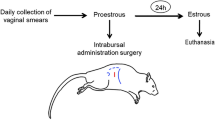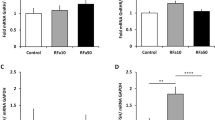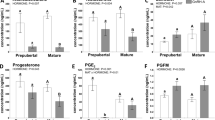Abstract
In the domestic hen, ovulation is preceded by an increase in plasma levels of luteinizing hormone (LH)1,2, but the local events within the ovary which lead to follicular rupture are not clearly understood. The mechanism of ovulation is thought to involve enzymatic activity3, morphological change in the stigma4 and neuromuscular activity modulated by α-adrenergic receptors5. The administration of anti-adrenergic drugs in vivo inhibits ovulation6,7, while the largest ovarian follicles contain high concentrations of noradrenaline and adrenaline, and low levels of dopamine8. We have now examined the possibility that these catecholamines, in addition to LH, are involved in the ovulatory process at the ovarian level. We found that noradrenaline and adrenaline induce ovulation independently of LH and that this action is mediated through α-adrenergic receptors at the follicle level. Dopamine does not seem to have any direct role in this process.
This is a preview of subscription content, access via your institution
Access options
Subscribe to this journal
Receive 51 print issues and online access
$199.00 per year
only $3.90 per issue
Buy this article
- Purchase on Springer Link
- Instant access to full article PDF
Prices may be subject to local taxes which are calculated during checkout
Similar content being viewed by others
References
Furr, B. J. A., Bonney, R. C., England, K. J. & Cunningham, F. J. J. Endocr. 57, 159–169 (1973).
Wilson, S. C. & Sharp, P. J. J. Reprod. Fert. 35, 561–564 (1973).
Nakajo, S., Zakaria, A. H. & Imai, K. J. Reprod. Fert. 34, 235–240 (1973).
Nalbandov, A. V. in Control of Ovulation (ed. Villee, C. A.) 122–132 (Pergamon, London, 1961).
Soliman, K. F. A. & Walker, C. A. Gen. comp. Endocr. 30, 372–377 (1976).
Ferrando, G. & Nalbandov, A. V. Endocrinology 85, 38–42 (1969).
Kao, L. W. L. & Nalbandov, A. V. Endocrinology 90, 1343–1349 (1972).
Moudgal, R. P. thesis, Haryana Agricultural Univ., Hissar, India (1981).
Spector, S., Shore, P. A. & Brodie, B. B. J. Pharmac. exp. Ther. 128, 15–21 (1960).
Garg, B., Buckner, C., Sokoloski, T. & Patil, P. N. Pharmacologist 12, 306 (1970).
Continho, E. M. & Maia, H. S. Nature new Biol. 235, 94–96 (1971).
Virutamasen, P., Hickok, R. L. & Wallach, E. E. Fert. Steril. 22, 235–243 (1973).
O'Shea, J. D. & Phillips, R. E. Biol. Reprod. 10, 370–379 (1974).
Rocereto, T., Jacobwitz, D. & Wallach, E. E. Endocrinology 84, 1336–1341 (1969).
Author information
Authors and Affiliations
Rights and permissions
About this article
Cite this article
Moudgal, R., Razdan, M. Induction of ovulation in vitro by LH and catecholamines in hens is mediated by α-adrenergic receptors. Nature 293, 738–739 (1981). https://doi.org/10.1038/293738a0
Received:
Accepted:
Issue Date:
DOI: https://doi.org/10.1038/293738a0
This article is cited by
Comments
By submitting a comment you agree to abide by our Terms and Community Guidelines. If you find something abusive or that does not comply with our terms or guidelines please flag it as inappropriate.



